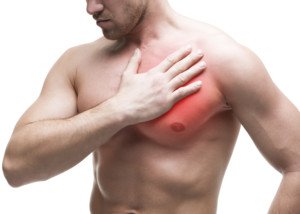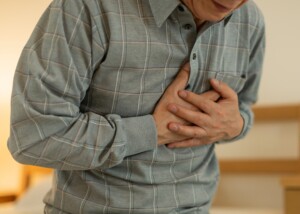
Is that chest tightness and shortness of breath from exercise induced asthma?
OR is it angina, in which blood flow to the heart is reduced due to clogged arteries?
The symptoms of angina and exercise induced asthma have some overlap.
“Asthma symptoms typically include chest tightness, shortness of breath and wheezing,” says Angel Coz, MD, FCCP, board certified pulmonologist, Associate Professor of Medicine, University of Kentucky, Lexington Veterans Affairs Medical Center.
“While they can happen at rest, they are more frequent during exercise. The symptoms can resemble those of angina that also tend to be aggravated by exertion.
“However, asthma symptoms will typically be relieved by asthma inhalers, whereas angina will not.
“Moreover, angina is usually associated with other presenting symptoms like arm discomfort, lightheadedness, nausea or diaphoresis (excessive sweat). Angina is relieved by nitroglycerin.”
Nitroglycerin for angina episodes comes in the form of a very small pill that the patient places beneath the tongue.
The drug’s job is to dilate blood vessels. When the vessels in the heart are dilated, more blood flows through them, providing symptom relief.
- Angina that’s triggered by physical activity or exercise is called stable angina.
- When it occurs at rest, it is called unstable angina. It can even occur during sleep and awaken the patient.
By definition, exercise induced asthma would occur only during some kind of physical exertion such as a cardio machine workout, aerobics class or strength training, and it is quickly relieved by using an inhaler.
Also keep in mind that EIA typically presents with a distinctive wheezing sound, and this is absent during a bout of angina.
If you suspect angina, ask your cardiologist about undergoing a cardiac stress test. You’ll want a complete cardiac workup, in fact.
Another Doctor’s Take on Angina Symptoms vs. Asthma from Exercise
“Angina is a pain in the chest that may spread to the shoulders, arms or neck,” says Walter Gaman, MD, FABFM, board certified in family medicine and the author of several award-winning books including “Age to Perfection: How to Thrive to 100, Happy, Healthy, and Wise.”
So right off the bat, if chest pain is accompanied by shoulder, arm or neck pain, this points heavily to angina.
But not all angina episodes involve the shoulder, arms or neck. Sometimes there’s just the chest pain.
“It’s caused when the heart is not supplied with an adequate amount of blood,” says Dr. Gaman.
“The heart needs oxygen to work properly, and oxygen gets to the heart through the blood. This pain is associated with underlying coronary artery disease where the vessels of the heart have narrowing.
“Angina is generally relieved with nitroglycerin and does not usually present with shortness of breath.”
But that doesn’t mean shortness of breath is not impossible with clogged arteries.
Sometimes, coronary artery disease will make itself known via feeling you can’t get enough oxygen.
For example, a walk to the corner mailbox suddenly feels like you just walked up several flights of stairs: You’re uncharacteristically short of breath.
“Many patients mistake angina for indigestion,” adds Dr. Gaman. “Because the heart requires more oxygen and more blood during exercise, angina may present during exercise or times of stress.
“Exercise induced asthma is different that angina. While it may also include pain to the chest, it is accompanied by shortness of breath and often audible wheezing.”
This audible wheezing is called stridor. There may also be difficulty in only exhaling, while not inhaling. Angina would never cause this.
So between a wheezing or vague whistling sound when trying to breathe, and more difficulty breathing out rather than in, this occurrence during exercise heavily suggests an asthma attack.
The shortness of breath during exercise induced asthma is more than just “I feel winded.”
During a brisk walk on a treadmill, the person suddenly feels they can’t breathe well enough to get in enough air. They step off the treadmill, struggling for breath. To an observer, it can appear alarming.
Someone with an angina attack will also remove their feet from a treadmill and start taking deep breaths, but will not appear in overt distress – as there will not be a mechanical issue with filling the lungs with air like there is with asthma.
“Asthma is caused by restricted airflow to the lungs,” says Dr. Gaman. “Exercise induced asthma is when this restriction happens with exercise.
“People who suffer exercise induced asthma are often put on an inhaler to relieve symptoms, but if the asthma attack is serious and not relieved by the inhaler, it can become serious enough for an urgent visit to the doctor or emergency room.”
 Dr. Coz is a pulmonary and critical care specialist at the Lexington Veterans Affairs Medical Center. He has a special interest in sepsis resuscitation and medical education.
Dr. Coz is a pulmonary and critical care specialist at the Lexington Veterans Affairs Medical Center. He has a special interest in sepsis resuscitation and medical education.

Dr. Gaman is with Executive Medicine of Texas and is with the Staying Young Radio Show 2.0 podcast.
 Lorra Garrick has been covering medical, fitness and cybersecurity topics for many years, having written thousands of articles for print magazines and websites, including as a ghostwriter. She’s also a former ACE-certified personal trainer.
Lorra Garrick has been covering medical, fitness and cybersecurity topics for many years, having written thousands of articles for print magazines and websites, including as a ghostwriter. She’s also a former ACE-certified personal trainer.
.









































